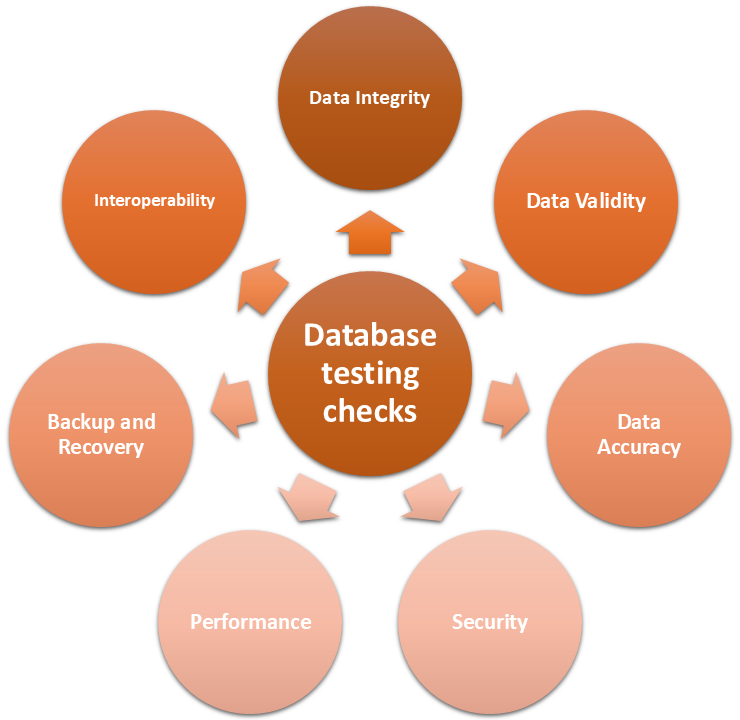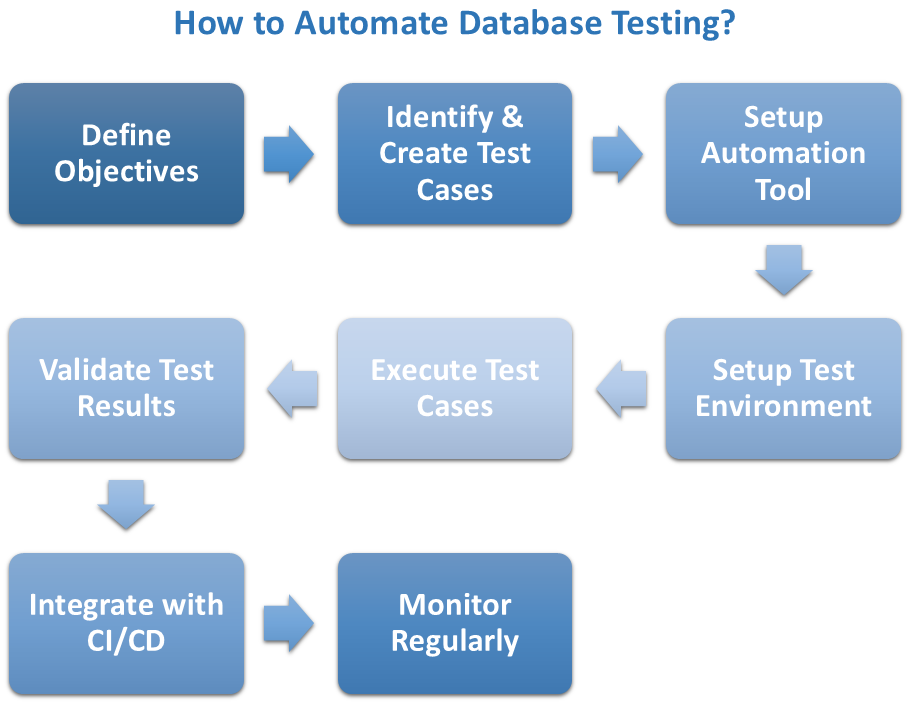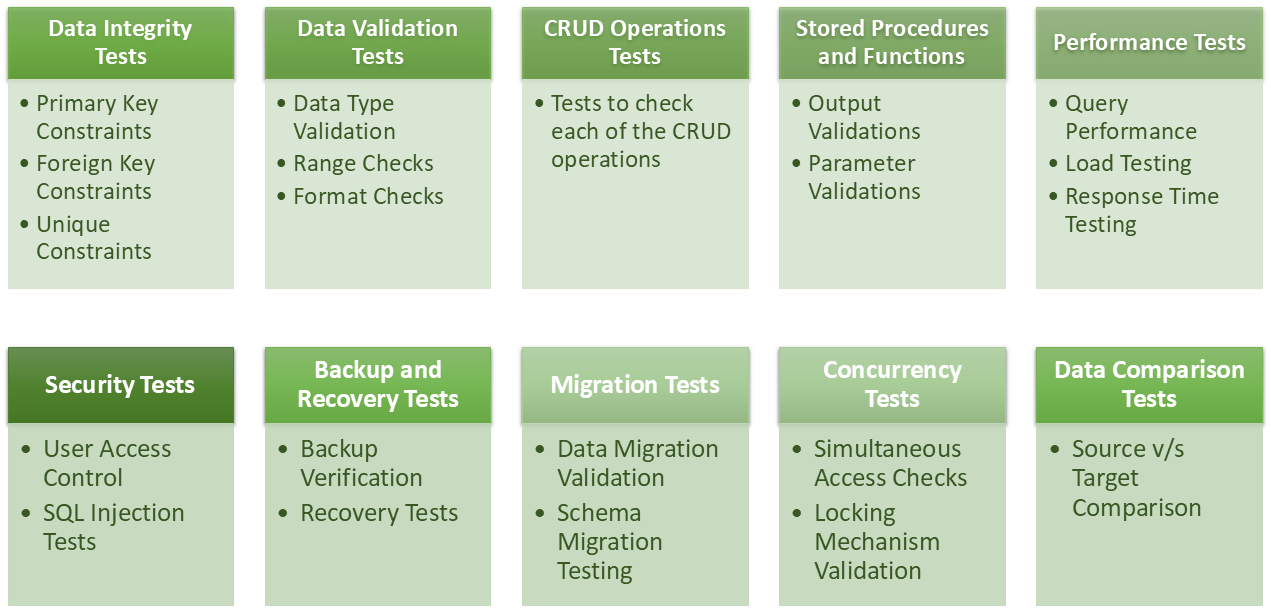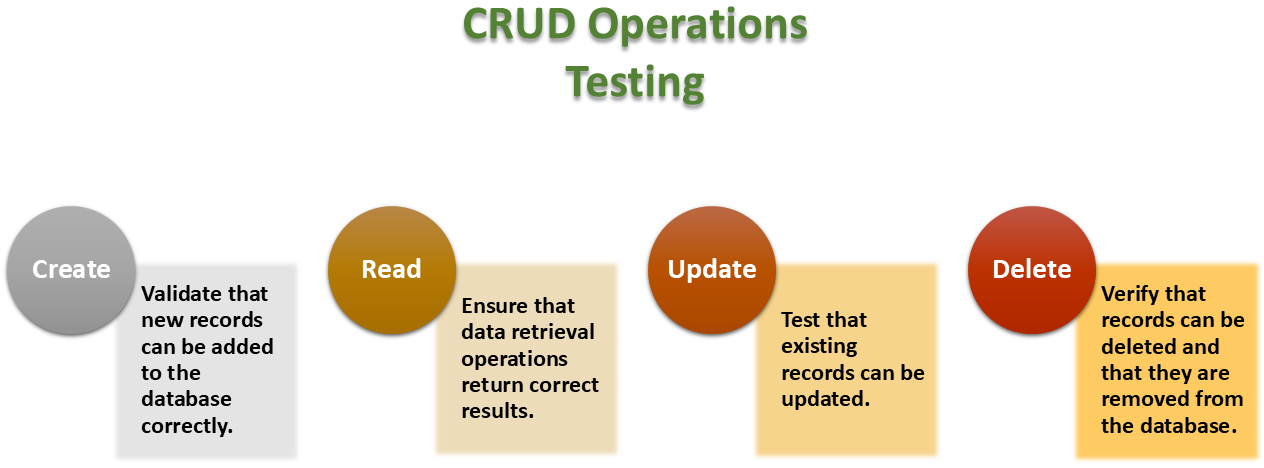How to Automate Database Testing?
|
|
Imagine a scenario where a bank’s online system is undergoing a significant upgrade. The developers have worked tirelessly to implement new features and improve performance. But what happens if a simple oversight in the database schema causes the system to crash during peak hours, resulting in financial losses and customer dissatisfaction?
This is one of many possible scenarios that highlight why database testing should be part of your testing strategy.
What is Database Testing?
Database testing is a way to ensure that your database is functioning correctly and efficiently in conjunction with the application that uses it. It involves verifying that the database functions as intended, meets performance requirements, and is secure against potential threats.
What Gets Tested in Database Testing?
Database testing covers a wide range of aspects:
- Primary Key and Foreign Key Constraints: To ensure that relationships between tables are maintained and that there are no orphan records.
- Unique Constraints: To validate that fields defined to be unique do not have duplicate values.
- Data Validity: Check that the data entered into the database conforms to defined formats and ranges (e.g., email formats and date ranges).
- Data Accuracy: Compares the data in the database with expected results to ensure accuracy.
- Data Security: Verifies user access controls and permissions to ensure that only authorized users can access or modify data.
- Data Migration: Testing during data migration processes to ensure data is transferred accurately from one database to another without loss or corruption.
- Performance Testing: Analyzes the database’s performance under various load conditions to ensure it can handle expected traffic and respond quickly to queries. Read about Scalability Testing.
- Stored Procedures and Triggers: Tests stored procedures, triggers and functions to verify their logic, performance and output, etc.
- Backup and Recovery Testing: Ensures that backup processes work correctly and that data can be restored from backups without issues.
- Concurrency Testing: This test measures how the database handles simultaneous operations to ensure data consistency and integrity when multiple users access the database at the same time.
- SQL Query Testing: Validates that SQL queries return the expected results and perform optimally.
- Database Configuration: Checks that database settings, configurations, and parameters are set correctly for optimal performance.

Why Automate Database Testing?
In today’s digital era, software development teams are under constant pressure to deliver high-quality applications quickly. Database testing is a critical component of this process as it ensures that the underlying data store functions correctly and reliably. However, manual database testing can be time-consuming, error-prone, and often overlooked.
This is where automated database testing comes into play. You can benefit significantly from automating database testing as it inherits the benefits of automated testing like:
- Increased Efficiency: Automated tests can be executed much faster than manual testing, allowing teams to run a large number of tests in a short period. This is particularly beneficial during regression testing or when you need to verify complex queries.
- Consistency and Accuracy: Automation reduces human error which ensures that tests are performed consistently every time. This leads to more reliable and accurate test results which is crucial for maintaining data integrity.
- Reusability of Test Scripts: Once created, automated test scripts can be reused across different projects or testing cycles, which saves time and effort. They can be easily adapted for new testing scenarios without starting from scratch.
- Frequent Testing: Automation enables continuous testing, which allows teams to run tests frequently, such as with each code change in a CI/CD pipeline. This helps identify issues early in the development cycle and reduces the cost and effort required to fix defects later.
- Comprehensive Test Coverage: Automated testing can cover a broader range of test scenarios that include edge cases and performance tests, which may be difficult to execute manually. This leads to better overall coverage and quality assurance.
- Integration with CI/CD Pipelines: Automated database tests can be seamlessly integrated into CI/CD processes to ensure that any changes to the application or database are validated automatically before deployment.
- Easier Performance Testing: Automation makes it easier to simulate high-load scenarios and measure database performance which helps to identify bottlenecks and optimize queries or configurations.
- Rapid Feedback Loop: Through automated tests, you can give immediate feedback to developers, thus enabling the identification and resolution of issues faster. This agility supports a more responsive development process.
- Cost-Effectiveness: While there may be an initial investment in tools and the development of automated tests, the long-term savings from the reduced manual testing effort, faster release cycles, and fewer defects can be substantial. Some interesting reads on related topics – What is the Cost of Quality in Software Testing? and Understanding the Total Cost of Ownership(TCO) of Test Automation.
How to Automate Database Testing?
Like automating any other form of testing, you need to go about the process systematically. Here’s a step-by-step guide to help you automate database testing.

Define Your Testing Goals
Determine what you want to test by automating database testing. Do you want to verify data integrity, validate performance, or test stored procedures?
Create Good Test Cases
Develop clear and concise test cases based on your objectives to cover various scenarios, such as CRUD (Create, Read, Update, Delete) operations, constraint validation, and error handling.
Here is a list of test cases that are automated in the majority of scenarios:


Here are some useful resources to help you with designing and writing good test cases:
- Mastering Test Design: Essential Techniques for Quality Assurance Experts
- Test Design Techniques: BVA, State Transition, and more
- How to Write Test Cases? (+ Detailed Examples)
Choose the Right Tools
Select automation tools based on your technology stack and requirements. Some commonly used tools for database testing include:
- DbUnit: A JUnit extension for database testing in Java.
- SQL Server Management Studio (SSMS): For SQL Server databases.
- Apache JMeter: For performance and load testing.
- Selenium: For validating database states as part of web application testing.
- Postman: For testing API endpoints that interact with the database.
You can go for some intelligent AI-based alternatives as well that not only help you with database testing but also take care of other types of testing. One popular example of such a tool is testRigor. While this tool primarily takes care of cross-platform end-to-end testing, it also supports database testing in good capacity. Here’s a guide that explains how testRigor does this – How to do database testing using testRigor?
Set Up Your Test Environment
Having good test cases and tools isn’t enough. You need an environment to run them in as well. Here are two strategies to help you prepare a good test environment.
- Isolated Test Database: Create a dedicated test database that mimics the production environment but is isolated to avoid any data corruption.
- Test Data Management: Prepare a set of test data that includes various scenarios, ensuring it covers edge cases.
Integrate with CI/CD
Integrate your automated tests into your Continuous Integration/Continuous Deployment (CI/CD) pipeline to ensure tests run automatically with every build or deployment.
Execute Tests
Execute the automated test scripts as per your defined schedule which could comprise of nightly builds or on code changes. Consider running tests in parallel to save time especially for performance testing.
Validate Results
Analyze the results of your tests against expected outcomes to determine if the tests passed or failed. Implement logging for test execution results to track failures, performance metrics, and other important data.
Reporting
Use reporting tools or features in your automation framework to generate comprehensive test reports, including pass/fail status, execution times, and error details. Regularly review test reports to identify trends or recurring issues in the database.
Maintain Test Scripts
Continuously update and maintain test scripts to reflect changes in the database schema, business logic, or application functionality. You can store your test scripts in a version control system (e.g., Git) to track changes and collaborate. However, if you are using one of those AI-based testing tools, then they will have built-in version control systems. Here’s an informative read on how testRigor reduced test maintenance time drastically by leveraging AI – Decrease Test Maintenance Time by 99.5% with testRigor
Monitor Performance
Finally, after deployment, monitor the database performance to ensure it meets expected standards and that automated tests align with real-world usage.
Common Challenges Associated with Automated Database Testing
While automating database testing might seem like the ultimate solution to all your woes, it is still riddled with challenges. Here are are some of the common ones:
- Data Dependency: Databases often rely on complex data relationships and dependencies. Automating tests that accurately simulate these relationships can be challenging, especially when dealing with large datasets.
- Frequent Changes: If your database contains frequently changing or dynamic data, creating reliable automated tests can be difficult. You may need to implement strategies to handle data variability, and changes in test scripts may also be needed for frequently updated schemas.
- Testing Concurrent Transactions: Validating how the database handles multiple concurrent transactions can be complex, particularly in reproducing race conditions or deadlocks.
- Performance Testing: Automating performance tests can be complex as they often involve simulating realistic workloads and measuring response times. This requires careful consideration of factors like concurrency, load distribution, and data volume.
- Security Testing: Automating security tests can be challenging due to the need to simulate various attack scenarios and vulnerabilities. This often requires specialized tools and expertise.
- Integration with Other Systems: If your database interacts with other systems or applications then automating tests may involve coordinating interactions between multiple components which can increase complexity.
- Test Data Management: Managing test data can be a significant challenge, especially when dealing with large datasets or sensitive information. Ensuring that test data is representative, secure, and up-to-date is essential for effective testing. You can utilize intelligent test automation tools to take care of generating unique test data through plain English commands, see here how.
- Tool Limitations: Some automated testing tools may have limitations regarding their capabilities or compatibility with specific database systems. Choosing the right tool is crucial to address these challenges.
- Maintenance and Updates: Automated test scripts may need to be regularly updated to reflect changes in the database schema or application logic. This can be time-consuming and requires ongoing maintenance.
Conclusion
Today, automating database testing is no longer an option but a necessity. By following the steps outlined in this post, you can effectively implement automated database testing practices and reap the benefits of improved efficiency, accuracy, and reliability. Remember, a well-tested database is the foundation of a robust and successful application. So don’t hesitate to utilize the power of test automation and take your database testing to the next level.
| Achieve More Than 90% Test Automation | |
| Step by Step Walkthroughs and Help | |
| 14 Day Free Trial, Cancel Anytime |












